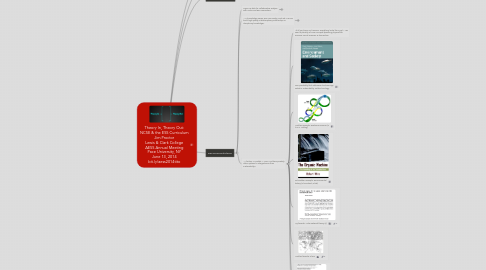
1. Theory?
1.1. "A manifesto for theory in ESS" (2013)
1.1.1. Theory as...
1.1.1.1. ...≠ practice? Nope
1.1.1.2. ...explanatory hypothesis (little t theory)
1.1.1.3. ...an implicit/explicit framework for understanding (big T Theory)
1.1.1.4. ...a vehicle; an idea that takes you places. Theory thus involve choices: which vehicle? where to go?
1.1.2. Why need more (explicit) theory in ESS? Interdisciplinarity creates challenges
1.1.2.1. Inclusivity (breadth of ESS)
1.1.2.2. Coherence (integrity of ESS)
1.2. Why so little (explicit) theory in ESS? Possible explanations
1.2.1. ESS a secondary/applied field for many practitioners
1.2.2. Overriding praxis mandate (but see above)
1.2.3. It's so darn hard to do (intellectually/politically/etc.) in ESS
2. Theory In/Out
2.1. NCSE (2013)
2.1.1. Undergraduate programs
2.1.1.1. Knowledge components
2.1.1.1.1. Ideal curriculum
2.1.1.1.2. Current curriculum
2.1.1.2. Skills components
2.1.2. Graduate programs
2.2. Roles of ESS & NCSE
2.3. 41 (> 7) > 3 > 1: Important theoretical assumptions
3. Three Theory Steps
3.1. 1. {The ideal ESS curriculum builds on diverse forms of knowledge}
3.1.1. What knowledge areas ought to be included in the NCSE study, and how should they be organized? [41 total; "The knowledge and skills areas were vetted by a number of (ESS) experts," p 10 + fn 3]
3.1.1.1. Natural sciences (7)
3.1.1.1.1. E.g., "Ecology"
3.1.1.2. Social sciences (4)
3.1.1.2.1. E.g., "Behavioral Social Sciences (e.g. sociology, anthropology, psychology, organization development, cultural studies)"
3.1.1.3. Humanities (6)
3.1.1.3.1. E.g., "Philosophy and Ethics (e.g. ontology, epistemology, logic, values, culture, diversity)"
3.1.1.4. Applied/professional (10)
3.1.1.4.1. E.g., "Agriculture (e.g. soils, range management, organic, sustainable)"
3.1.1.5. Interdisciplinary (8)
3.1.1.5.1. E.g., "Water Systems (e.g. scarcity, allocation, hydrology)"
3.1.1.6. Sustainability (6)
3.1.1.6.1. E.g., "Social Sustainability (social aspects of sustainable development/sustainability)"
3.1.2. How compatible are these ESS knowledge areas? Some are; some aren't. [Table 2 p 13]
3.1.2.1. Example correlation: "Sustainability" vs. "Social Sciences" = 0.592. Many others large/positive as well. A big happy family!
3.1.2.2. But "Physical Sciences" vs. "Social Sciences" = -0.300; "Life Sciences vs. "Social Sciences" = -0.214! Natural vs. social science preferences not compatible.
3.1.3. How diverse, really, are ideal ESS curricula? Rank order of top 12 of 41 knowledge areas by mean importance (0-3) suggests a narrower spectrum. [App D p 57]
3.1.3.1. 1. Environmental sustainability (2.48)
3.1.3.2. 2. Sustainability general concepts (2.43)
3.1.3.3. 3. Climate change/disruption (2.34)
3.1.3.4. 4. Ecology (2.33)
3.1.3.5. 5. Biology (2.20)
3.1.3.6. 6. Water systems (2.08)
3.1.3.7. 7. Policy and public administration (2.05)
3.1.3.8. 8. Earth sciences/geology (2.03)
3.1.3.9. 9. Chemistry (1.96)
3.1.3.10. 10. Natural resources management (1.96)
3.1.3.11. 11. Economics (1.91)
3.1.3.12. 12. Sustainability science (1.89)
3.2. 2. {This diverse knowledge can be organized into major curricular models}
3.2.1. How find patterns among 41 knowledge areas in 242 undergraduate programs? Several steps, the first involving factor analysis...
3.2.1.1. Ex: 14 biodiversity measures (right) across 32 sites (left) in N/S America
3.2.2. How closely did 7 identified factors in NCSE study match knowledge area categories in survey? A alot (Table 1 p 12)
3.2.2.1. Natural sciences area (7)
3.2.2.1.1. "Physical sciences"; "Life sciences" factors
3.2.2.2. Social sciences area (4)
3.2.2.2.1. "Social sciences" factor
3.2.2.3. Humanities area (6)
3.2.2.3.1. "Humanities" factor
3.2.2.4. Applied/professional area (10)
3.2.2.4.1. "Built environment" factor
3.2.2.5. Interdisciplinary area (8)
3.2.2.5.1. "Systems" factor
3.2.2.6. Sustainability area (6)
3.2.2.6.1. "Sustainability" factor
3.2.3. How did the NCSE study derive & name the 3 curricular models derived from 7 factors? Cluster/discriminant analysis...
3.2.3.1. Factor emphasis per model (Figure 5 p 19)
3.2.3.2. 2 axes for the 3 models (Figure 7 p 20)
3.2.3.2.1. "Sustainability & solutions" axis
3.2.3.2.2. "Natural sciences & traditional research" axis
3.2.3.3. Summary results (Figure 4 p 18)
3.2.4. What is the larger context here?
3.2.4.1. p 37: "An analysis by…argues that an 'ecosystem of expertise' is needed to effectively develop, implement, and manage sustainability projects. This expertise should include (1) an 'outreach expert who communicates effectively…,' (2) an 'interdisciplinarity expert who understands the overlaps of neighboring disciplines,' (3) a 'meta-expert who brokers…multiple claims…,' and (4) a 'civic expert who engages in democratic discourse….'"
3.2.4.1.1. Outreach expert: Social systems model
3.2.4.1.2. Interdisciplinary expert: Natural systems model
3.2.4.1.3. Meta-expert: Sustainability solutions model
3.2.4.1.4. Civic expert: Social systems model
3.3. 3. {Sustainability lies at the core of these curricular models}
3.3.1. Summary results (Figure 4, p. 18)...but "Problem solving for sustainability" not empirically derived.
3.3.2. What is the ESS context here?
3.3.2.1. Rapid growth in sustainability programs (p. 9): 13 (2008) to 141 (2012)!
3.3.2.2. Precedents (Vincent & Focht)
3.3.2.2.1. "In search of common ground: Exploring identity and core competencies for interdisciplinary environmental programs" (2010): "We suggest that sustainability/sustainable development could be considered a candidate for forging consensus…on core competencies in interdisciplinary environmental degree curricula."
3.3.2.2.2. "Interdisciplinary environmental education: Elements of field identity and curriculum design" (2011, p. 27)
3.3.3. What is the larger context here?
3.3.3.1. p. 37: "Sherburne Abbott…has identified five waves of the environmental movement:…(5) the sustainability movement 1990-present."
4. Recommendations
4.1. Open up data for collaborative analysis with NCSE and ESS researchers.
4.1.1. Ideal vs. current curricula?
4.1.2. Greater clarity on natural vs. social science preferences?
4.1.3. Conversations on factor/cluster naming?
4.2. ~41 knowledge areas!! ESS community must ask: Can we build high-quality interdisciplinary scholarship on disciplinary knowledge?
4.2.1. Pros: Cutting-edge (vs. introductory) disciplinary knowledge is what ESS often ignores
4.2.2. Cons: Arguably impossible to assemble a core to ESS from the outside in
4.3. ~7 factors, 3 models, 1 core! Are there possibly other options to integrate ESS than sustainability?
4.3.1. "If all you have is a hammer, everything looks like a nail"...we need a plurality of core concepts spanning physical/life sciences, social sciences, & humanities.
4.3.2. One possibility that addresses shortcomings noted in sustainability: Political ecology
4.3.3. Another example: Resilience science (à la C.S. Holling)
4.3.4. Yet another example: Environmental history (à la Richard White)
4.3.5. My favorite: Actor-network theory (?)
4.3.6. Another favorite: Place
4.3.7. Another example: Human dignity
4.3.8. ...and many more, all necessitating theoretical conversation!
